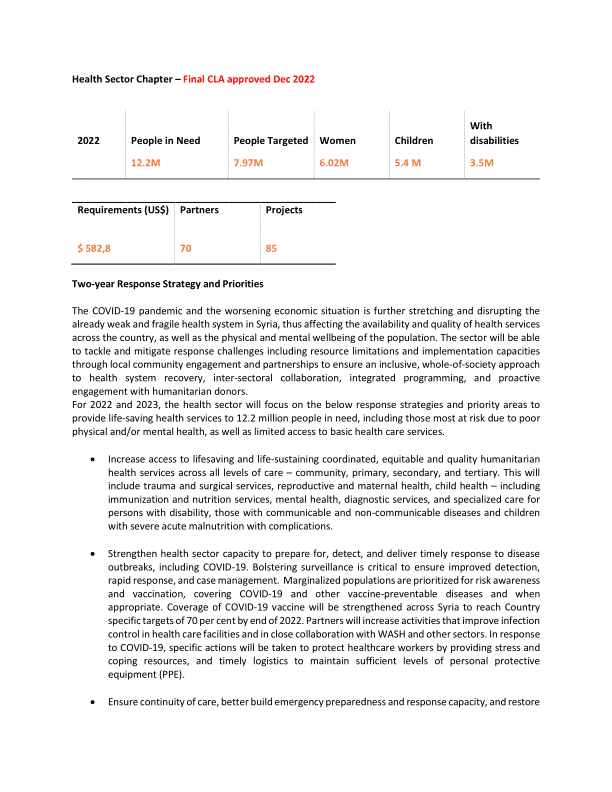Health Sector Chapter – Final CLA approved Dec 2022
2022
People in Need 12.2M
People Targeted 7.97M
Women 6.02M
Children 5.4 M
With disabilities 3.5M
Requirements (US$) $582,8
Partners 70
Projects 85
Two-year Response Strategy and Priorities The COVID-19 pandemic and the worsening economic situation is further stretching and disrupting the already weak and fragile health system in Syria, thus affecting the availability and quality of health services across the country, as well as the physical and mental wellbeing of the population. The sector will be able to tackle and mitigate response challenges including resource limitations and implementation capacities through local community engagement and partnerships to ensure an inclusive, whole-of-society approach to health system recovery, inter-sectoral collaboration, integrated programming, and proactive engagement with humanitarian donors.
For 2022 and 2023, the health sector will focus on the below response strategies and priority areas to provide life-saving health services to 12.2 million people in need, including those most at risk due to poor physical and/or mental health, as well as limited access to basic health care services.
• Increase access to lifesaving and life-sustaining coordinated, equitable and quality humanitarian health services across all levels of care – community, primary, secondary, and tertiary. This will include trauma and surgical services, reproductive and maternal health, child health – including immunization and nutrition services, mental health, diagnostic services, and specialized care for persons with disability, those with communicable and non-communicable diseases and children with severe acute malnutrition with complications.
• Strengthen health sector capacity to prepare for, detect, and deliver timely response to disease outbreaks, including COVID-19. Bolstering surveillance is critical to ensure improved detection, rapid response, and case management. Marginalized populations are prioritized for risk awareness and vaccination, covering COVID-19 and other vaccine-preventable diseases and when appropriate. Coverage of COVID-19 vaccine will be strengthened across Syria to reach Country specific targets of 70 per cent by end of 2022. Partners will increase activities that improve infection control in health care facilities and in close collaboration with WASH and other sectors. In response to COVID-19, specific actions will be taken to protect healthcare workers by providing stress and coping resources, and timely logistics to maintain sufficient levels of personal protective equipment (PPE).
• Ensure continuity of care, better build emergency preparedness and response capacity, and restore damaged and non-functional health facilities in an effort to mainstream early recovery in the health response in Syria, address health inequity and ensure access for marginalized and vulnerable populations, especially those at greater risk of being left behind. Further expansion of essential health services package in all areas at primary and secondary care, pre-service and in-services trainings of health care workers must be complemented with strengthened supply chain management and health information systems, and bolstered linkages with communities through outreach efforts such as community health workers, mobile medical units and ambulance services.


